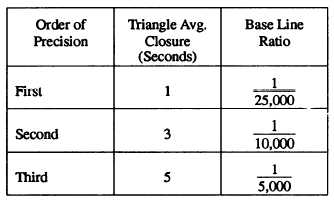3.
4.
5.
6.
Measurement of angles
Determination of direction (or azimuth)
Base line measurement
Computations
Reconnaissance
The first consideration with regard to the selection
of stations is, of cause, intervisibility. An observation
between two stations that are not intervisible is
impossible. Next comes accessibility. Obviously again,
a station that is inaccessible cannot be occupied and
between two stations otherwise equally feasible, the one
that provides the easier access is preferable.
The next consideration involves strength of figure.
In triangulation, the distances computed (that is, the
lengths of triangle sides) are computed by way of the
law of sines. Ths more nearly equal the angles of a
triangle are, the less will be the ratio of error in the sine
computations. The ideal triangle, then would be one in
which each of the three angles measured 60°; this
triangle would, of course, be both equiangular and
equilateral.
Values computed from the sines of angles near 0°
or 180° are subject to large ratios of error. As a general
rule, you should select stations that will provide
triangles in which no angle is smaller than 30° or larger
than 150°.
Signal Erection
After the stations have been selected, the
triangulation signals or triangulation towers should be
erected When you erect triangulation towers or signals,
remember that it is imperative for these stations to be
intervisible. It is also important that the target be large
enough to be seen at a distance; that is, the color of the
target must be selected for good visibility against the
background where it will be viewed. When observations
are made during daylight hours with the sun shining, a
heliotrope is a very effective target. When triangulation
surveys are made at night, lights must be used for
targets. Therefore, target sets with built-in illuminations
are very effective.
Measurement of Angles
The precision with which angles in the system are
measured will depend on the order of precision
prescribed for the survey. The precision of a
triangulation system may be classified according to (1)
the average error of closure of the triangles in the system
and (2) the ratio of error between the measured length
of a base line and its length as computed through the
system from an adjacent base line. Large government
triangulation surveys are classified in precision
categories as follows:
15-32
For third-order precision, angles measured with a
1-minute transit will be measured with sufficient
precision if they are repeated six times. As explained in
chapter 13 of the EA3 TRAMAN, six repetitions with a
1-minute transit measures angles to the nearest 5
seconds. To ensure elimination of certain possible
instrumental errors, you should make half of the
repetitions with the telescope erect and half with the
telescope reversed. In each case, the horizon should be
closed around the station.
Determination of Direction
As you learned earlier in this chapter, most
astronomical observations are made to determine the
true meridian from which all azimuths are referred In
first-order triangulation systems, these observations are
used to determine latitude and longitude. Once the true
meridian is established, the azimuths of all other sides
are computed from the true meridian.
To compute the coordinates of triangulation
stations, you must determine the latitudes and
departures of the lines between stations; to do this, you
must determine the directions of these lines. The
latitude of a traverse line means the length of the line
as projected on the north-south meridian running
through the point of origin. The departure of a traverse
line means the length of the line as projected on the
east-west parallel running through the point of origin
Latitudes and departures are discussed in detail in
chapter 7 of this TRAMAN.


